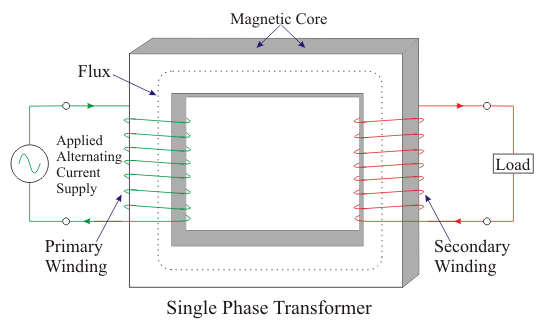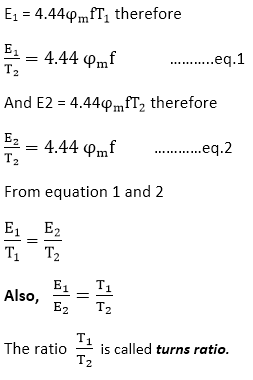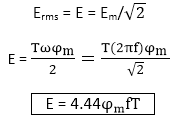Single Phase TransformerThe transformer is a static device which converts the magnetic energy into electrical energy. It consists of two or more than two stationary circuits interlinked by a common magnetic circuit; the energy transfer takes place through this circuit without having any change in frequency from one circuit to another. 
The transformer consists of two windings. The winding which is connected with the supply a.c. voltage is called the primary winding, and the winding which is connected to load and delivers the energy to load is called secondary winding. E.M.F. Equation of a TransformerLet the flux at any point is given by φ= φm sin ω t The instantaneous e.m.f. induced in a coil of T turns linked by this flux is given by Faraday's law as 
The above equation can also be written as 
Where Em = Tωφm =maximum value of e. For sine wave, the r.m.s. value is given by Erms = E = Em/ This is called as e.m.f. equation of transformer. Where, φm is the maximum flux in webers (Wb) f is the frequency in hertz (Hz) E is the voltage in volts T is number of turns in winding The primary r.m.s. voltage is E1 = 4.44φm fT1 The secondary r.m.s. voltage is E2 = 4.44φm fT2 Voltage Ratio and Turns RatioThe ratio E/T is called voltage per turn. As we know 
Step - up transformer: These are the transformer in which the output voltage is higher than the input voltage. Step - down transformer: These are the transformer in which the output voltage is less than the input voltage. NOTE: The same transformer can be used as a step up transformer and step down transformer by changing the way it is connected. If we want the transformer to work as a step up transformer, then low voltage winding is the primary, and if we want it to work as a step-down transformer, then high voltage winding is the primary.
Next TopicConstruction of single Phase transformer
|
 For Videos Join Our Youtube Channel: Join Now
For Videos Join Our Youtube Channel: Join Now
Feedback
- Send your Feedback to [email protected]
Help Others, Please Share











